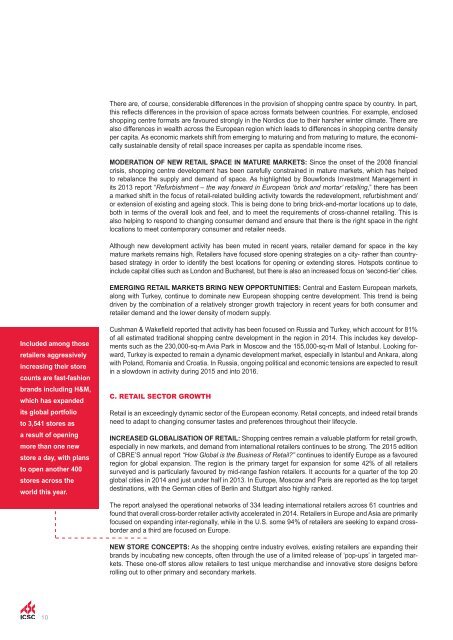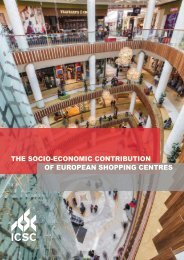THE SOCIO-ECONOMIC CONTRIBUTION OF EUROPEAN SHOPPING CENTRES
Create successful ePaper yourself
Turn your PDF publications into a flip-book with our unique Google optimized e-Paper software.
There are, of course, considerable differences in the provision of shopping centre space by country. In part,<br />
this reflects differences in the provision of space across formats between countries. For example, enclosed<br />
shopping centre formats are favoured strongly in the Nordics due to their harsher winter climate. There are<br />
also differences in wealth across the European region which leads to differences in shopping centre density<br />
per capita. As economic markets shift from emerging to maturing and from maturing to mature, the economically<br />
sustainable density of retail space increases per capita as spendable income rises.<br />
MODERATION <strong>OF</strong> NEW RETAIL SPACE IN MATURE MARKETS: Since the onset of the 2008 financial<br />
crisis, shopping centre development has been carefully constrained in mature markets, which has helped<br />
to rebalance the supply and demand of space. As highlighted by Bouwfonds Investment Management in<br />
its 2013 report “Refurbishment – the way forward in European ‘brick and mortar’ retailing,” there has been<br />
a marked shift in the focus of retail-related building activity towards the redevelopment, refurbishment and/<br />
or extension of existing and ageing stock. This is being done to bring brick-and-mortar locations up to date,<br />
both in terms of the overall look and feel, and to meet the requirements of cross-channel retailing. This is<br />
also helping to respond to changing consumer demand and ensure that there is the right space in the right<br />
locations to meet contemporary consumer and retailer needs.<br />
Although new development activity has been muted in recent years, retailer demand for space in the key<br />
mature markets remains high. Retailers have focused store opening strategies on a city- rather than countrybased<br />
strategy in order to identify the best locations for opening or extending stores. Hotspots continue to<br />
include capital cities such as London and Bucharest, but there is also an increased focus on ‘second-tier’ cities.<br />
EMERGING RETAIL MARKETS BRING NEW OPPORTUNITIES: Central and Eastern European markets,<br />
along with Turkey, continue to dominate new European shopping centre development. This trend is being<br />
driven by the combination of a relatively stronger growth trajectory in recent years for both consumer and<br />
retailer demand and the lower density of modern supply.<br />
Included among those<br />
retailers aggressively<br />
increasing their store<br />
counts are fast-fashion<br />
brands including H&M,<br />
which has expanded<br />
its global portfolio<br />
to 3,541 stores as<br />
a result of opening<br />
more than one new<br />
store a day, with plans<br />
to open another 400<br />
stores across the<br />
world this year.<br />
Cushman & Wakefield reported that activity has been focused on Russia and Turkey, which account for 81%<br />
of all estimated traditional shopping centre development in the region in 2014. This includes key developments<br />
such as the 230,000-sq-m Avia Park in Moscow and the 155,000-sq-m Mall of Istanbul. Looking forward,<br />
Turkey is expected to remain a dynamic development market, especially in Istanbul and Ankara, along<br />
with Poland, Romania and Croatia. In Russia, ongoing political and economic tensions are expected to result<br />
in a slowdown in activity during 2015 and into 2016.<br />
C. RETAIL SECTOR GROWTH<br />
Retail is an exceedingly dynamic sector of the European economy. Retail concepts, and indeed retail brands<br />
need to adapt to changing consumer tastes and preferences throughout their lifecycle.<br />
INCREASED GLOBALISATION <strong>OF</strong> RETAIL: Shopping centres remain a valuable platform for retail growth,<br />
especially in new markets, and demand from international retailers continues to be strong. The 2015 edition<br />
of CBRE’S annual report “How Global is the Business of Retail?” continues to identify Europe as a favoured<br />
region for global expansion. The region is the primary target for expansion for some 42% of all retailers<br />
surveyed and is particularly favoured by mid-range fashion retailers. It accounts for a quarter of the top 20<br />
global cities in 2014 and just under half in 2013. In Europe, Moscow and Paris are reported as the top target<br />
destinations, with the German cities of Berlin and Stuttgart also highly ranked.<br />
The report analysed the operational networks of 334 leading international retailers across 61 countries and<br />
found that overall cross-border retailer activity accelerated in 2014. Retailers in Europe and Asia are primarily<br />
focused on expanding inter-regionally, while in the U.S. some 94% of retailers are seeking to expand crossborder<br />
and a third are focused on Europe.<br />
NEW STORE CONCEPTS: As the shopping centre industry evolves, existing retailers are expanding their<br />
brands by incubating new concepts, often through the use of a limited release of ‘pop-ups’ in targeted markets.<br />
These one-off stores allow retailers to test unique merchandise and innovative store designs before<br />
rolling out to other primary and secondary markets.<br />
10



